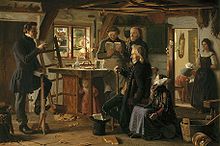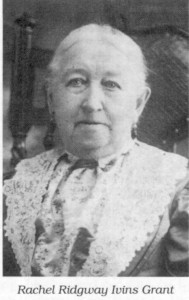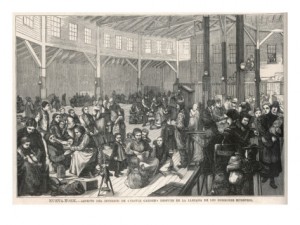Archive for the ‘Historical Notes’ Category
Monday, October 29th, 2012
 Given the state of medical knowledge during the 19th century, it seems likely that missionaries could have unwittingly spread disease, as they traveled from area to area. Historically, traveling merchants are today thought to have been a factor in spreading disease around the world, although I’m not sure to what extent that was known historically. It was considered a possibility early in Mormon history, if the following article is any indication. Local residents in Western New York State feared that Mormons might spread smallpox, and that Mormon beliefs might exacerbate the possibility:
Given the state of medical knowledge during the 19th century, it seems likely that missionaries could have unwittingly spread disease, as they traveled from area to area. Historically, traveling merchants are today thought to have been a factor in spreading disease around the world, although I’m not sure to what extent that was known historically. It was considered a possibility early in Mormon history, if the following article is any indication. Local residents in Western New York State feared that Mormons might spread smallpox, and that Mormon beliefs might exacerbate the possibility:
(more…)
Like this:
Like Loading...
Posted in Historical Notes | No Comments »
Wednesday, October 24th, 2012
 For early Mormon church members in Nauvoo the death of Joseph Smith and the ensuing anti-mormon violence must have been very traumatic. With the trek westward beginning more than 18 months after the martyrdom and with initial uncertainty over who exactly should lead the Church, many members must have been uncertain what to do. And at least some of them decided to just go home.
For early Mormon church members in Nauvoo the death of Joseph Smith and the ensuing anti-mormon violence must have been very traumatic. With the trek westward beginning more than 18 months after the martyrdom and with initial uncertainty over who exactly should lead the Church, many members must have been uncertain what to do. And at least some of them decided to just go home.
(more…)
Like this:
Like Loading...
Tags: Hornerstown, Philip Curtis, Rachel R. Ivins, Return, Thomas A. Lyne
Posted in Historical Notes | No Comments »
Wednesday, October 17th, 2012
In the mid to late 19th century, if you knew something unusual, of public interest, you set up a series of lectures on the issue, and toured starting in New York and Boston. Like it is today, this was a very common approach to the issues of the day, something less expensive and involved than publishing a book (in fact, it was a common way of promoting a book), and something that allowed discussion of issue more complex and involved than what could be published in newspapers. And Mormonism was one of those frequent topics that appeared on the lecture circuit.
(more…)
Like this:
Like Loading...
Tags: Artemus Ward, Books, Boston, Boylston Hall, Clinton Hall, George J. Adams, Hope Chapel, John C. Bennett, John Hyde, Josiah Quincy, Lectures, Mark Twain, National Hall, New York, Origen Bachelor, Thomas A. Lyne, William Smith
Posted in Historical Notes | No Comments »
Thursday, October 11th, 2012
 This past week I came across a couple of newspaper articles suggesting that Mormons were looking to rent or even acquire real estate in Philadelphia in the 1840s. Given that there were perhaps 300 Church members in Philadelphia at the time, the idea seems improbable. But, these claims made the newspapers at the time.
This past week I came across a couple of newspaper articles suggesting that Mormons were looking to rent or even acquire real estate in Philadelphia in the 1840s. Given that there were perhaps 300 Church members in Philadelphia at the time, the idea seems improbable. But, these claims made the newspapers at the time.
(more…)
Like this:
Like Loading...
Tags: Assembly Building, Benjamin Winchester, Chestnut Street Theatre, George J. Adams, Philadelphia, Real Estate, Thomas A. Lyne
Posted in Historical Notes | 6 Comments »
Friday, September 28th, 2012
[I’m sorry that I’ve been negligent in posting this past two months. Vacation and what I might call “recovery from vacation” have thrown me off my schedule. I hope to return to posting weekly or close to it.]
If you think of American political tactics before 1850, images of political machines like Tammany Hall and violent disagreement quickly come to mind. Given that, we might expect that the conventions held in support of Joseph Smith’s candidacy for President of the United States might have at least occasionally attracted opposition from local machines, even if the attempt didn’t have much chance of success.
So I wasn’t surprised to find that the “Jeffersonian” convention held in Boston on July 1st, 1844 (news of Joseph Smith’s martyrdom hadn’t yet reached Boston) was labeled a “Mormon War” by the time news of the convention was reprinted in the New York Herald on July 4th. That report came from the Boston Times of July 2nd. The following extract gives an account of what happened:
(more…)
Like this:
Like Loading...
Posted in Historical Notes | No Comments »
Wednesday, July 25th, 2012
When news of the martyrdom of Joseph Smith reached New York City and was published in the major New York newspapers on July 8th, Church members in the city were initially cautious about the news. Reports of Joseph Smith’s death or some other tragedy had appeared before and turned out to be incorrect.
The Latter Day Saint newspaper in New York, The Prophet, had already cautioned members on June 29th (probably because of the scandalous news reports similar to what was published in the Nauvoo Expositor, which were then reaching New York City) “not to credit the many tales afloat respecting our people, we have had no intelligence of trouble, and doubt very much the truth of these statements.”
But church members received confirmation of the martyrdom by July 20th, which left them wondering how to mourn for the fallen prophet.
(more…)
Like this:
Like Loading...
Tags: Brooklyn, crape, Martyrdom, New York branch, New York City, Philadelphia, Samuel Brannan, The Prophet, Token of Respect, wearing black, William Smith, Williamsburgh
Posted in Historical Notes | No Comments »
Wednesday, July 18th, 2012
Two weeks ago I wrote about the fundraising attempt in New York City that was meant to help the Mormons who had been driven from Nauvoo. In fact, that was the second time that Mormons solicited funds in New York City for the relief of those driven from a state. The first time came in 1839, after Mormons had been driven from Missouri. Of the two attempts, the first was more successful.
(more…)
Like this:
Like Loading...
Tags: Charles King, John P. Greene, National Hall
Posted in Historical Notes | No Comments »
Tuesday, July 10th, 2012
In the winter of 1887-1888, the Church made a significant change to how it handled immigration through New York City. Before this time Mormon immigrants to teh United States were met by an immigration agent in New York City, one of a network of agents at each transition point whose responsibilities were to help the immigrants on their way. But starting with immigration companies in 1888, there was no longer a Church immigration agent.
(more…)
Like this:
Like Loading...
Posted in Historical Notes | 2 Comments »
Tuesday, July 3rd, 2012
While LDS Church members are usually very familiar with the travails of those who took part in the pioneer trek, starting in 1846, few are familiar with the attempts to get non-Mormon help to alleviate the suffering of those on the trek. Seeing the need, many LDS leaders and missionaries spread across the U.S. seeking donations to help the destitute cross the plains starting in the winter of 1846-47. But their efforts found significant success only when they found an important and influential friend: Thomas L. Kane. And it is clearly through Kane’s efforts that then New York City Mayor William V. Brady.
(more…)
Like this:
Like Loading...
Posted in Historical Notes | 1 Comment »
Friday, June 22nd, 2012
 In the latter half of the 19th century, the principle role that New York City filled for Mormonism was as a transit point—more than 75,000 Mormon converts entered the United States through New York City during those years while several thousand missionaries sailed for Europe from New York’s port. But beginning with the Page Act in 1875 and the Chinese Exclusion Act of 1882, the U.S. began restricting immigration, beginning with Chinese and also including convicts, lunatics, and “others unable to care for themselves.” And in the late 1880s, attention on polygamy prosecution in Utah led to a provision of the Geary Act of 1892 which prohibited entry by polygamists. If you were restricted from immigrating, you were sent back.
In the latter half of the 19th century, the principle role that New York City filled for Mormonism was as a transit point—more than 75,000 Mormon converts entered the United States through New York City during those years while several thousand missionaries sailed for Europe from New York’s port. But beginning with the Page Act in 1875 and the Chinese Exclusion Act of 1882, the U.S. began restricting immigration, beginning with Chinese and also including convicts, lunatics, and “others unable to care for themselves.” And in the late 1880s, attention on polygamy prosecution in Utah led to a provision of the Geary Act of 1892 which prohibited entry by polygamists. If you were restricted from immigrating, you were sent back.
(more…)
Like this:
Like Loading...
Posted in Historical Notes | 8 Comments »
 Given the state of medical knowledge during the 19th century, it seems likely that missionaries could have unwittingly spread disease, as they traveled from area to area. Historically, traveling merchants are today thought to have been a factor in spreading disease around the world, although I’m not sure to what extent that was known historically. It was considered a possibility early in Mormon history, if the following article is any indication. Local residents in Western New York State feared that Mormons might spread smallpox, and that Mormon beliefs might exacerbate the possibility:
Given the state of medical knowledge during the 19th century, it seems likely that missionaries could have unwittingly spread disease, as they traveled from area to area. Historically, traveling merchants are today thought to have been a factor in spreading disease around the world, although I’m not sure to what extent that was known historically. It was considered a possibility early in Mormon history, if the following article is any indication. Local residents in Western New York State feared that Mormons might spread smallpox, and that Mormon beliefs might exacerbate the possibility:

